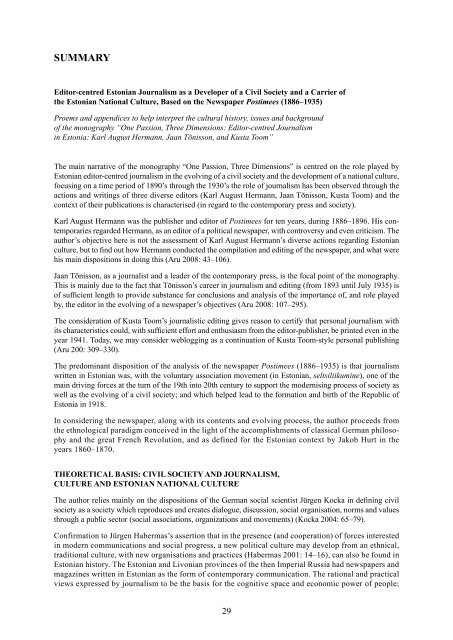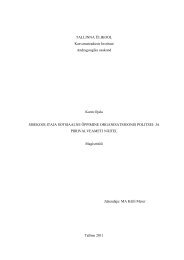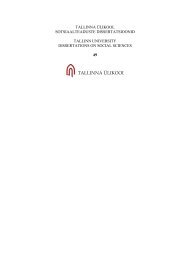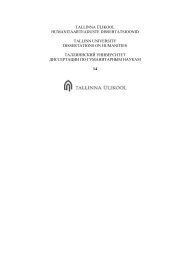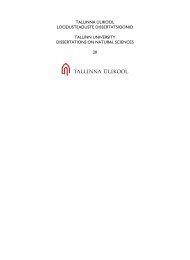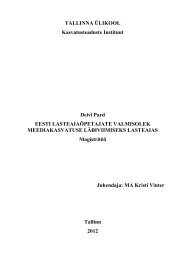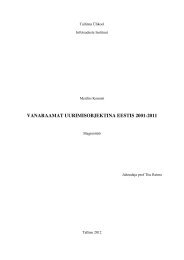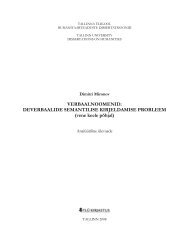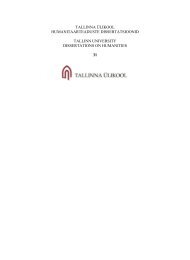Create successful ePaper yourself
Turn your PDF publications into a flip-book with our unique Google optimized e-Paper software.
SUMMARY<br />
Editor-centred Estonian Journalism as a Developer of a Civil Society and a Carrier of<br />
the Estonian National Culture, Based on the Newspaper Postimees (1886–1935)<br />
Proems and appendices to help interpret the cultural history, issues and background<br />
of the monography “One Passion, Three Dimensions: Editor-centred Journalism<br />
in Estonia: Karl August Hermann, Jaan Tõnisson, and Kusta Toom”<br />
The main narrative of the monography “One Passion, Three Dimensions” is centred on the role played by<br />
Estonian editor-centred journalism in the evolving of a civil society and the development of a national culture,<br />
focusing on a time period of 1890’s through the 1930’s the role of journalism has been observed through the<br />
actions and writings of three diverse editors (Karl August Hermann, Jaan Tõnisson, Kusta Toom) and the<br />
context of their publications is characterised (in regard to the contemporary press and society).<br />
Karl August Hermann was the publisher and editor of Postimees for ten years, during 1886–1896. His contemporaries<br />
regarded Hermann, as an editor of a political newspaper, with controversy and even criticism. The<br />
author’s objective here is not the assessment of Karl August Hermann’s diverse actions regarding Estonian<br />
culture, but to find out how Hermann conducted the compilation and editing of the newspaper, and what were<br />
his main dispositions in doing this (Aru 2008: 43–106).<br />
Jaan Tõnisson, as a journalist and a leader of the contemporary press, is the focal point of the monography.<br />
This is mainly due to the fact that Tõnisson’s career in journalism and editing (from 1893 until July 1935) is<br />
of sufficient length to provide substance for conclusions and analysis of the importance of, and role played<br />
by, the editor in the evolving of a newspaper’s objectives (Aru 2008: 107–295).<br />
The consideration of Kusta Toom’s journalistic editing gives reason to certify that personal journalism with<br />
its characteristics could, with sufficient effort and enthusiasm from the editor-publisher, be printed even in the<br />
year 1941. Today, we may consider weblogging as a continuation of Kusta Toom-style personal publishing<br />
(Aru 200: 309–330).<br />
The predominant disposition of the analysis of the newspaper Postimees (1886–1935) is that journalism<br />
written in Estonian was, with the voluntary association movement (in Estonian, seltsiliikumine), one of the<br />
main driving forces at the turn of the 19th into 20th century to support the modernising process of society as<br />
well as the evolving of a civil society; and which helped lead to the formation and birth of the Republic of<br />
Estonia in 1918.<br />
In considering the newspaper, along with its contents and evolving process, the author proceeds from<br />
the ethnological paradigm conceived in the light of the accomplishments of classical German philosophy<br />
and the great French Revolution, and as defined for the Estonian context by Jakob Hurt in the<br />
years 1860–1870.<br />
Theoretical Basis: Civil Society and Journalism,<br />
Culture and Estonian National Culture<br />
The author relies mainly on the dispositions of the German social scientist Jürgen Kocka in defining civil<br />
society as a society which reproduces and creates dialogue, discussion, social organisation, norms and values<br />
through a public sector (social associations, organizations and movements) (Kocka 2004: 65–79).<br />
Confirmation to Jürgen Habermas’s assertion that in the presence (and cooperation) of forces interested<br />
in modern communications and social progress, a new political culture may develop from an ethnical,<br />
traditional culture, with new organisations and practices (Habermas 2001: 14–16), can also be found in<br />
Estonian history. The Estonian and Livonian provinces of the then Imperial Russia had newspapers and<br />
magazines written in Estonian as the form of contemporary communication. The rational and practical<br />
views expressed by journalism to be the basis for the cognitive space and economic power of people;<br />
29


